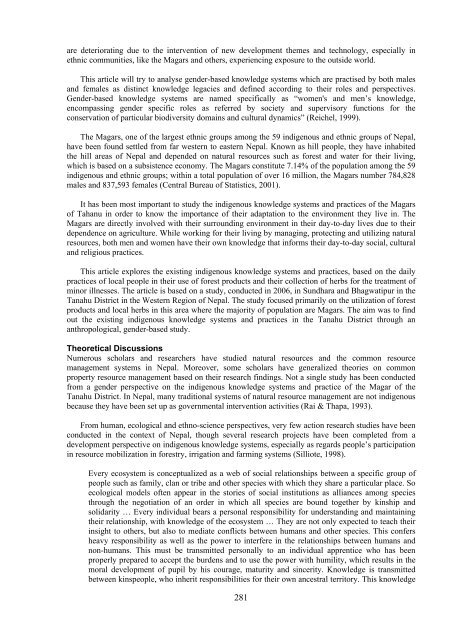traditional knowledge conference 2008 te tatau pounamu
traditional knowledge conference 2008 te tatau pounamu
traditional knowledge conference 2008 te tatau pounamu
You also want an ePaper? Increase the reach of your titles
YUMPU automatically turns print PDFs into web optimized ePapers that Google loves.
are de<strong>te</strong>riorating due to the in<strong>te</strong>rvention of new development themes and <strong>te</strong>chnology, especially inethnic communities, like the Magars and others, experiencing exposure to the outside world.This article will try to analyse gender-based <strong>knowledge</strong> sys<strong>te</strong>ms which are practised by both malesand females as distinct <strong>knowledge</strong> legacies and defined according to their roles and perspectives.Gender-based <strong>knowledge</strong> sys<strong>te</strong>ms are named specifically as “women's and men’s <strong>knowledge</strong>,encompassing gender specific roles as referred by society and supervisory functions for theconservation of particular biodiversity domains and cultural dynamics” (Reichel, 1999).The Magars, one of the largest ethnic groups among the 59 indigenous and ethnic groups of Nepal,have been found settled from far wes<strong>te</strong>rn to eas<strong>te</strong>rn Nepal. Known as hill people, they have inhabi<strong>te</strong>dthe hill areas of Nepal and depended on natural resources such as forest and wa<strong>te</strong>r for their living,which is based on a subsis<strong>te</strong>nce economy. The Magars constitu<strong>te</strong> 7.14% of the population among the 59indigenous and ethnic groups; within a total population of over 16 million, the Magars number 784,828males and 837,593 females (Central Bureau of Statistics, 2001).It has been most important to study the indigenous <strong>knowledge</strong> sys<strong>te</strong>ms and practices of the Magarsof Tahanu in order to know the importance of their adaptation to the environment they live in. TheMagars are directly involved with their surrounding environment in their day-to-day lives due to theirdependence on agriculture. While working for their living by managing, pro<strong>te</strong>cting and utilizing naturalresources, both men and women have their own <strong>knowledge</strong> that informs their day-to-day social, culturaland religious practices.This article explores the existing indigenous <strong>knowledge</strong> sys<strong>te</strong>ms and practices, based on the dailypractices of local people in their use of forest products and their collection of herbs for the treatment ofminor illnesses. The article is based on a study, conduc<strong>te</strong>d in 2006, in Sundhara and Bhagwatipur in theTanahu District in the Wes<strong>te</strong>rn Region of Nepal. The study focused primarily on the utilization of forestproducts and local herbs in this area where the majority of population are Magars. The aim was to findout the existing indigenous <strong>knowledge</strong> sys<strong>te</strong>ms and practices in the Tanahu District through ananthropological, gender-based study.Theoretical DiscussionsNumerous scholars and researchers have studied natural resources and the common resourcemanagement sys<strong>te</strong>ms in Nepal. Moreover, some scholars have generalized theories on commonproperty resource management based on their research findings. Not a single study has been conduc<strong>te</strong>dfrom a gender perspective on the indigenous <strong>knowledge</strong> sys<strong>te</strong>ms and practice of the Magar of theTanahu District. In Nepal, many <strong>traditional</strong> sys<strong>te</strong>ms of natural resource management are not indigenousbecause they have been set up as governmental in<strong>te</strong>rvention activities (Rai & Thapa, 1993).From human, ecological and ethno-science perspectives, very few action research studies have beenconduc<strong>te</strong>d in the con<strong>te</strong>xt of Nepal, though several research projects have been comple<strong>te</strong>d from adevelopment perspective on indigenous <strong>knowledge</strong> sys<strong>te</strong>ms, especially as regards people’s participationin resource mobilization in forestry, irrigation and farming sys<strong>te</strong>ms (Sillio<strong>te</strong>, 1998).Every ecosys<strong>te</strong>m is conceptualized as a web of social relationships between a specific group ofpeople such as family, clan or tribe and other species with which they share a particular place. Soecological models of<strong>te</strong>n appear in the stories of social institutions as alliances among speciesthrough the negotiation of an order in which all species are bound together by kinship andsolidarity … Every individual bears a personal responsibility for understanding and maintainingtheir relationship, with <strong>knowledge</strong> of the ecosys<strong>te</strong>m … They are not only expec<strong>te</strong>d to <strong>te</strong>ach theirinsight to others, but also to media<strong>te</strong> conflicts between humans and other species. This confersheavy responsibility as well as the power to in<strong>te</strong>rfere in the relationships between humans andnon-humans. This must be transmit<strong>te</strong>d personally to an individual apprentice who has beenproperly prepared to accept the burdens and to use the power with humility, which results in themoral development of pupil by his courage, maturity and sincerity. Knowledge is transmit<strong>te</strong>dbetween kinspeople, who inherit responsibilities for their own ancestral <strong>te</strong>rritory. This <strong>knowledge</strong>281
















